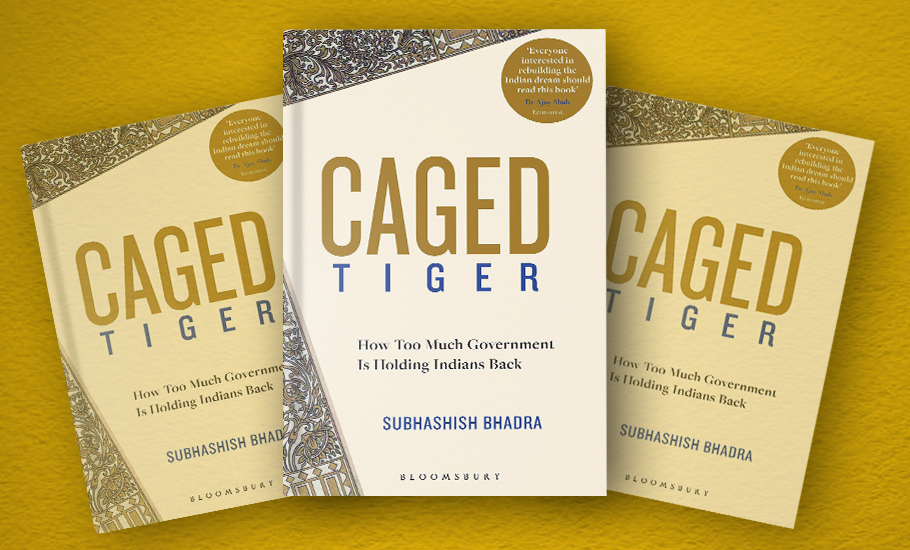
Subhashish Bhadra interview: How India can transform itself from an elephant to a tiger

“Why do governments get so much say over what is shared on social media? Why are taxpayers unable to easily see where their taxes and donations are spent? Why are our Parliament and state legislatures unable to question governments effectively?” asks Subhashish Bhadra, author of the book Caged Tiger: How Too Much Government is Holding Indians Back (Bloomsbury India) and director at Klub, a financing platform for digital businesses.
The book explores topics such as democracy, institutional design, economic growth, citizenship, free speech, and regulatory mechanisms. It engages with contemporary debates in a language that combines rigour with accessibility. It looks into questions of constitutional morality, government overreach, and marriage equality.
Bhadra is an economist by training. He completed his BA in Economics at St. Stephen’s College, Delhi, and received an M.Phil. in economics from the University of Oxford in the UK. In this interview, he discusses some of the key ideas in his debut book at length. Excerpts:
Why did you choose to call your debut book Caged Tiger? Could you help us unpack the metaphor here?
The metaphor usually used for India is that of an elephant — large and steady, but also slow and lumbering. That metaphor is also appropriate for Indian governments, which are perceived to be stable but inflexible. The weight of an unnecessarily expansive government, in turn, holds Indians back from being the best versions of themselves.
If it didn’t exist, more of us could be entrepreneurs and innovators, our art and cinema would break new ground, and we would live our lives with greater agency and purpose. The unchained energy of a billion-plus Indians would transform India from an elephant to a tiger. Powerful, courageous and decisive. The book speaks about how we can make that change.
What kind of academic and professional experiences helped you develop your thinking around ‘how too much government is holding Indians back’?
My educational training is in economics, where the question of the appropriate level of government intervention is as old as the discipline itself. After I came back to India from Oxford in 2016, I spent half a decade at a grant-making organization that funded India’s leading think-tanks. By interacting with some of India’s brightest minds, I developed greater appreciation for the nuts-and-bolts of governance. I have also worked closely with entrepreneurs for many years and observed how governance affects the innovation economy.
Also read: Pico Iyer broadens the idea of paradise, shows we are all bound up in our humanity
Most importantly, I have worked and interacted with many bureaucrats and some politicians. Between the research and corporate worlds, I experienced government from different perspectives in a way that not many do. The lens that resonated most with me was that of institutional structure, and I felt that it was a story that needed to be brought alive for readers who are not as familiar with these issues. That’s how Caged Tiger was born.
You mention that the people involved in framing the Constitution of India deliberately did not include the right to privacy among the fundamental rights. What were their reasons?
To answer this question, we need to understand what was going through our founders’ minds in those years. India was in the midst of social and economic unrest, exacerbated by the trauma of partition. Jawaharlal Nehru’s writings from that time warn of dark corridors and primeval nights. Sardar Patel spoke of times ‘when men would not be men and law would not be law’.
To keep the country together, our founders decided to create a powerful government with expansive policing powers. Many members of the Constituent Assembly, such as Kazi Syed Karimuddin, Somnath Lahiri and Harman Singh, sought to include some version of the Right to Privacy in the Constitution. However, such attempts failed because the majority felt that governments needed a freer hand to deal with the uncertainties of that time.
How have societal, legal and political understandings of privacy changed between then and now?
In the first few decades following Independence, privacy was seen primarily as a physical concept, limited to protection from unnecessary home searches or reading of private correspondence. Accordingly, the Supreme Court weighed it against the policing needs of the nascent Indian state and agreed that Indians do not have a Fundamental Right to Privacy. This began to change with the spread of technology in the 1990s, which made surveillance a more visible threat to liberty.

A 1996 judgment that put procedural safeguards around phone-tapping, for example, alluded to the Right to Privacy. The 2017 Supreme Court judgment that enshrined the Right to Privacy went much further and said that privacy is an intrinsic aspect of dignity, autonomy and liberty that the Constitution promises to us.
The right to privacy was central to the Supreme Court verdict that read down Section 377 of the Indian Penal Code. What implications does it have for legal recognition of marriage equality?
I take great hope from the broader reading of privacy by the Supreme Court. When we position privacy as a matter of dignity, autonomy and liberty, the obvious implication is that every Indian should have the ability to marry a person of their choice. I also think that the quest for marriage equality has to be framed in the broader context of dismantling the excessive role governments play in regulating our personal lives.
Also read: Why Kannada writer UR Ananthamurthy did not want to live in Modi-ruled India
In the book, for example, I talk about religious conversions. I have sympathy for the desire to prevent conversions due to coercion and allurement, but many states have written laws that go far beyond that by creating bureaucratic quagmires. I hope that the right to privacy gives us an anchor to be able to question such incursions into our dignity and autonomy, as it did by decriminalizing homosexuality in 2018 and adultery in 2019.
What are your thoughts on the Indian government’s insistence that the issue of marriage equality be debated in Parliament, and not left to the apex court of the country?
I am disappointed but not surprised. By design, governments represent the majoritarian will of the people and therefore want to protect their prerogative to make laws. Especially in times when the judiciary has been accused of encroaching on Parliament’s domain, I have some sympathy for this view. That said, minority rights of any kind cannot be left to the whims of majoritarian law-making. It took many years for our government to introduce GST, a reform that had wide bipartisan support. Getting to consensus on marriage equality will take a lot longer. In the interim, the rights of the LGBTQIA+ community cannot be kept in abeyance. I do not believe that the Supreme Court has the luxury of waiting for Parliament to rectify historical injustices. It must step in — and step in now!
In the book, you write, “We do not talk about institutions enough because we are too preoccupied with how we feel about the government leaders of the day.” Is it not essential for citizens in an electoral democracy to be concerned about how their representatives conduct themselves and hold them accountable? I am trying to understand what you mean. Would you like to elaborate?
It is absolutely essential for citizens to hold elected representatives accountable for their conduct. But do we have sufficient tools to do so today? Let’s think beyond the few thousand MPs and MLAs. Governments are much larger than that. Think of the constable in the police station, the official at the transport office or the doctor at a government hospital. Our lives are affected more by a nameless bureaucrat in Delhi who is writing laws than by our local MP. However, everyone from the President to the municipal worker is controlled by a maze of laws and regulations that I call institutions. Only by unpacking and fixing these institutions brick-and-brick can we hope to substantially improve our daily lives.
What do you find most appealing about “the marketplace of ideas”, a theoretical framework that you use in the book? How could various stakeholders in the current discourse around marriage equality benefit from understanding how this marketplace works?
Human civilization is undergoing tectonic and complex transformations, such as AI and global warming. No single person has all the answers and expertise. Yet, rising polarization has reduced the space for listening and collaboration. I believe we must rebuild the appetite for the messy negotiations of everyday politics. On marriage equality, for example, we need to make an effort to understand the concerns of the other side.
In their view, it waters down an institution that has been central to their way of life, raises unanswered questions about parenthood, and may even impact the country’s demography. Instead of banishing these concerns as illogical or illegitimate, we should educate the other side and ourselves by engaging in debate and discussion. Except for those that violate our constitutional ideals of equality and liberty, I believe that every idea brings us closer to creating a better society.
What are some of the lessons that India could learn from other countries that have institutionalized marriage equality not only in law but also in society?
If we look at the history of marriage equality in the United States of America, we notice that judicial advancements can be short-lived unless backed by public opinion. For example, supportive judicial decisions in 1993 and 2003 were followed by widespread counter-reactions by voters and lawmakers. In response, marriage equality advocates mounted a decades-long effort at changing public opinion.
Also read: David Baldacci interview: ‘Writing has always been an addiction, not a means of earning’
They ran it like a campaign, experimenting with new messages and testing their effectiveness. Through this, they found that framing the issue around love and values, rather than rights and benefits, helped mobilize public opinion. For example, the most effective ads were those where grandparents spoke about their journey of coming to terms with their grandchildren’s sexuality and wanting them to experience the love and belonging of married life. Such messages helped the marriage equality campaign to win hearts and minds, which made subsequent victories in court more permanent.
How did your dog, Leia, contribute to the making of this book?
An author’s journey can often be a lonely one. Mine was especially so because I wrote the book during the pandemic years. By a stroke of good fortune, I found Leia on the street one day. I tried to find her previous owners, but decided to take her in when that failed. Over the next few months, she became my anchor in life and an emotional sanctuary. Without her, I do not think I would have had the fortitude to weather the emotional roller-coaster of the publishing journey.

